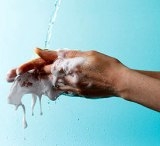
Posts Tagged: sanitation
Enjoy summer’s fruits and vegetables — safely
![Food blog 01 5751417888 59f0a8c3ca m[1] Food blog 01 5751417888 59f0a8c3ca m[1]](http://ucanr.org/blogs/food/blogfiles/7859.jpg)
According to Dr. Trevlor Suslow, a plant pathologist and Cooperative Extension specialist at UC Davis, “Americans consume more than six billion servings of uncooked fresh fruits and vegetables every year, versus a very small number of illnesses that are clearly linked to foodborne pathogens.”
The take-home message is that the food supply in the U.S. is generally very safe, particularly when everyone in the food supply chain (including consumers) does their part to assure food safety.
The U.S. Food and Drug Administration (FDA) recently released the following information for home consumers:
Nearly 48 million people (1 in 6 people) are sickened by food contaminated with harmful germs each year, and some of the causes might surprise you.
Although most people know animal products must be handled carefully to prevent illness, many don’t realize that produce can also be the culprit in foodborne illness. In recent years, the U.S. has had several outbreaks of illness caused by contaminated fruits and vegetables — including spinach, tomatoes, and lettuce.
Fresh produce can become contaminated in many ways. During the growing phase, fruits and veggies may be contaminated by animals, harmful substances in the soil or water, and poor worker hygiene. After produce is harvested, it passes through many hands, increasing the contamination risk. Contamination can even occur after the produce has been purchased, during food preparation, or through inadequate storage.
The FDA says to choose produce that isn’t bruised or damaged, and make sure that pre-cut items — such as bags of lettuce or watermelon slices — are either refrigerated or on ice both in the store and at home. In addition, follow these recommendations:
- Wash your hands for 20 seconds with water and soap before and after preparing fresh produce.
- Cut away any damaged or bruised areas before preparing or eating.
- Gently rub produce while holding under plain running water. There’s no need to use soap or a produce wash.
- Wash produce BEFORE you peel it, so dirt and bacteria aren’t transferred from the knife onto the fruit or vegetable.
- Use a clean vegetable brush to scrub firm produce, such as melons and cucumbers.
- Dry produce with a clean cloth or paper towel to further reduce bacteria that may be present.
- Throw away the outermost leaves of a head of lettuce or cabbage.
Store perishable produce in the refrigerator at 40 degrees or below.
(Condensed from an FDA news release. The site has an interesting video and useful links to other sites with food safety information.)
For more on what UC Davis and UC Cooperative Extension are doing to assure the safety of fresh produce:
- UC Food Safety website
- Postharvest Technology Center website
- Center for Produce Safety website
- UC publications
Food, hand-washing and the ick factor

There are many good reasons to wash hands:
- Pathogen spread – from yourself, from others, from one contaminated food to another (meats, produce, etc.)
- Chemical spread – whatever chemicals are on your hands can go directly into the food being prepared. This can include pesticides, hand sanitizers (ick), cleaning products, hand lotions, etc.
- The ick factor – “Ick, what’s that slime on your hands and do I really want that in my food?”
The most memorable item I learned about hand-washing is that we need to wash for at least 20 seconds — the time it takes to sing the entire “happy birthday song” twice (and slowly). Watch anyone in any kitchen or public bathroom, and very few come close to washing for that long.
It’s human nature to think that our own hands are cleaner than everyone else’s, and that maybe we ourselves have less need to wash our own hands before preparing food for others. Well, everyone benefits if we all wash our hands well before cooking or eating.
Many years ago I got giardia, which laid me out for weeks, and my doctor and I determined that I probably got it from a food-service worker who did not wash hands properly. A big “ick.” It was a real wake-up call about the need for hand-washing.
So, if you hear me singing the happy birthday song while washing my hands in the kitchen, you can be thankful for my commitment to good hygiene.
Guidelines for hand-washing
- Wet your hands with clean running water
- Apply liquid, bar, or powder soap
- Lather well
- Rub your hands vigorously for at least 20 seconds. Remember to scrub all surfaces, including the backs of your hands, wrists, between your fingers and under your fingernails
- Rinse well
- Dry your hands with a CLEAN or disposable towel or air dryer
- If possible, use your towel to turn off the faucet
(Information on hand-washing and using hand sanitizers can be found at the information sources below.)
Information sources for handwashing
- The Mayo Clinic
- The Centers for Disease Control and Prevention (CDC)
- CDC downloadable poster
- World Health Organization (WHO)
- WHO downloadable poster
Lastly, while we’re addressing kitchen sanitation, please use a clean tasting spoon each time you sample what you are cooking. It’s a really big ICK to taste from the stirring spoon, then put it back into the food. It’s also a way to spread germs, especially in uncooked foods. Yes, cooking may sanitize the spoon, but people still don’t want to eat other people's saliva, sterile or not.
Happy holidays, and stay clean and healthy!
UPDATE (Dec. 15, 2010): A new press release from the Centers for Disease Control and Prevention reports that 1 in 6 people get sick from foodborne illnesses each year. The CDC also reports that keeping hands clean is one of the best ways to prevent the spread of infection and illness.
